Cabeceras Aid Project
Spring 2005 Update

It is our pleasure to write you to tell you about the advances Cabeceras Aid Project has made since we wrote our last update in the fall of 2003, and to let you know what 2005 holds for our organization.
Change of Address
Cabeceras has moved its principal office to:
1303 Karen Ave, Austin TX 78757-3017
Overview of 2004
2004 was an especially intense and productive year in the field for Cabeceras. Our two principal fieldworkers, Lev Michael and Chris Beier, were in Peru for an entire year, from November 2003 to November 2004. Their extended stay was made possible by their doctoral dissertation research projects, and while in the jungle, they were able to advance several Cabeceras projects and to strengthen our organization's political network in Peru. This will greatly aid the effectiveness of Cabeceras' ongoing and future projects in collaboration with small indigenous communities in Peruvian Amazonia.
Cabeceras was also able expand the scope and productivity of its work in Peru by carrying out projects with the aid of two other fieldworkers, Catherine Clark and Edinson Huamancayo. Catherine Clark, who joined Cabeceras as a fieldworker in 2003, carried out an important project in the Purús River region, and Edinson Huamancayo carried out his first Cabeceras field project in the Omagua community of San Joaquin. You can read about these exciting projects below. Finally, we are lucky to count Gabel Sotíl, the sub-director for the Peruvian Department of Education for the state of Loreto, as a partner in Cabeceras' work.
Camisea Nanti Project
2004 was a landmark year in growing the relationship between Cabeceras and the Nanti communities on the upper Camisea River. Chris and Lev spent seven months in Montetoni in two periods, primarily working on their doctoral dissertation research. During this time we made substantial advances in documenting Nanti history, social and cultural practices, and various aspects of the Nanti language. Because of our extended stays, we were able to considerably deepen our understanding of Nantis' priorities, concerns, and desires for their own social and political future, which will make us all the more effective as allies in defending their well-being and self-determination in the future.
A significant development in the last year was the return of a schoolteacher to the Nanti community of Malanksiari and plans by the Dominican mission in the Urubamba River Valley to establish a school in Montetoni. The Nantis are at best ambivalent about these developments, with many voicing people concerns about the schools. In the 1990s, a schoolteacher living among the Nantis exploited them economically and showed tremendous disrespect for Nanti ways, and Nantis are worried that this may happen again.
In order to forestall that danger, we are currently working with AIDESEP, the major indigenous federation for Peruvian Amazonian peoples, to develop a culturally and politically appropriate education plan for the Nanti communities, which we will present to the Nantis as an alternative to the traditional kinds of schools with which the Nantis have had such bad experiences. Using our knowledge of Nanti culture and language we hope to develop a plan that will fill Nantis' long-term needs to obtain certain useful types of knowledge from the outside word (like writing), without causing social and political turmoil.
As a continuing aspect of our organization's work in the Nanti communities, Chris and Lev brought basic medical supplies to the health promoters in Montetoni and Malanksiari.
In other health-related matters, in 2004, a Peruvian Ministry of Health report was released on the health situation in the Nanti communities on the Camisea. This report was based on fieldwork carried out by a General Office of Epidemiology team that visited the Nanti communities in May 2003. We facilitated the team's work by providing Nanti translation and by sharing ethnographic and demographic data that we have been collecting systematically since 1997. The release of this report had a great political impact, and focused government and public attention on the health risks faced by the Nanti communities. As a result of the OGE team's work, the Ministry of Health has been more responsive to Nanti opinions and concerns in health-related issues. The report can be downloaded at www.oge.sld.pe/principal.htm. We also provided the same services and data to a parallel study carried out at the request of AIDESEP, the major indigenous federation for Peruvian Amazonian peoples. This report can be downloaded at www.lshtm.ac.uk/pehru/communities/camisea-salud.pdf.
Cabeceras also formed part of a multi-institutional effort to address the concerns of the multiple indigenous groups that live in the Reserva Kugapakori-Nahua with respect to their territorial rights. A report on these issues and a set of recommendations to the appropriate Peruvian government agencies will be completed by the end of January 2005. As a result of this work, Cabeceras will also soon be releasing a new comprehensive report on factors affecting Nanti well-being and self-determination, which we will make available to indigenous federations, NGOs, and Peruvian government agencies concerned with the welfare of indigenous peoples.
Urubamba River Valley Medical Aid Project
In December 2003, Chris and Lev once again delivered kits of basic medical supplies to the Machiguenga communities of Nueva Luz, Kirigueti, Camisea, and Segakiato. For several years, Cabeceras has provided supplies to the healthposts in these communities to serve individuals living in these communities and in more distant places who otherwise would have no access to cost-free medical care from Peru's healthcare system. As before, these kits were gratefully received, and we look forward to making another delivery of basic medical kits in the Urubamba River Valley in January 2005.
The purpose of the Urubamba River Valley Medical Aid Project is to help meet the medical needs of Machiguenga, Asháninka, and Kakinte communities while the Peruvian Ministry of Health is building its infrastructure in this region and until the Ministry is able to bring larger quantities of medicines into the region for its hospitals, healthposts, and community health promoters. In the interim, Cabeceras is responding to requests from medical personnel stationed in the region to ensure that communities do not have to do without critical, but basic, life-saving medicines.
Purús River Research Project
From July to September of 2004, Cabeceras sent fieldworker Catherine Clark to the upper Purús River region, one of the remotest areas of Peruvian Amazonia. Catherine's goal was to update our information regarding the Mashco Piros and the Mastanahuas, two indigenous groups living in voluntary isolation in the region, focusing on threats to their well-being and self-determination.
In 1999 Cabeceras published a report on these same issues (available at the Cabeceras website), which alerted indigenous federations and other NGOs to the threats faced by these groups, and which played a role in the creation of a protected area for them. Catherine's work determined that despite these efforts, there has been a tremendous escalation of illegal logging in the territories of these groups, and that drug traffickers have begun to use this remote region as a route to nearby Brazil. According to interviews carried out by Catherine, both loggers and drug traffickers have killed members of these groups in recent encounters. In addition, evangelical missionaries have continued efforts to make forced contact with these groups in order to convert them. Cabeceras is presently writing an updated report on the Purús situation and is working closely with AIDESEP, the major Amazonian indigenous federation, to address these serious threats to the well-being of these indigenous peoples.
Matsigenka Oral History Project
In 2003, a Matsigenka school teacher named Lucio Abral Turco approached Lev and Chris to propose that Cabeceras support him in carrying out a small research project to record oral histories of the Matsigenka community of Cashiriari. Lucio's motivation is two-fold: to create an oral history archive for the community; and to use these records to write a history of the community in order to complete his own professionalization program as a bilingual teacher.
Historical records for indigenous communities are very scarce, as are financial resources for the advanced education of Matsigenkas, so the opportunity to make progress on both fronts made Lev and Chris eager to support Abral, as it did Cabeceras' board members.
Cabeceras provided Lucio with a grant to carry out his research, and in 2004, Lucio completed his research in Cashiriari. He is presently writing his thesis. At the end of his project, he will provide copies of all of his recordings and written materials both to the community of Cashiriari and to Cabeceras Aid Project. In addition, he will then be a fully-certified Matsigenka bilingual teacher, and better able to provide culturally-sensitive and historically-informed education to Matsigenka children.
Omagua Documentation Project
In the fall of 2003, Cabeceras fieldworker Catherine Clark carried out a pilot study of the Omagua language, now spoken by fewer than 10 people in and around San Joaquin de Omaguas, in northern Peruvian Amazonia. Omagua was once the most widely spoken language in the Amazon Basin, with as many as 1.5 million speakers. Unfortunately, because the Omaguas lived on the main Amazon River itself, they suffered especially heavily from the Spanish and Portuguese conquest and its brutal legacy. Omagua is now virtually extinct and its few remaining speakers are in their 70s. Cabeceras has ascertained that without immediate action, this once vibrant language will disappear with almost no historical or linguistic documentation of its existence.
Fortunately, in 2003 Catherine made connections with members of the Omagua community who are enthusiastic about documenting their language and history, and with that groundwork laid, Cabeceras began a collaborative effort with them to document the language, history, and culture of the Omaguas. Cabeceras' first step was to send linguist Edinson Huamancayo to San Joaquin from May to June 2004, where he carried out 7 weeks of intensive linguistic documentation of Omagua. Edinson's work is the first descriptive work on Omagua since the 18th century, when it served as a lingua franca along the main Amazon River.
On the basis of Edinson's linguistic work, we were then able to begin working with Arnaldo Huanaquiri, the only literate Omagua speaker in San Joaquin, to write down and translate into Spanish the wealth of stories and historical information that he commands. Arnaldo has an amazing gift and passion for documenting his first language and culture, and had already begun documenting Omagua words when Cabeceras met him. He had, however, encountered great difficulties in writing down the language using the Spanish alphabet, the only one he knew. Edinson's research enabled him to create a specific script for Omagua that is capable of representing that language's unique sounds. With this new tool, additional training provided by Edinson in writing down and translating stories, and Cabeceras' financial support, Arnaldo has been producing notebook after notebook of Omagua stories and wordlists. Arnaldo speaks of this work as his best opportunity to create permanent records and resources for future generations of his people. As a result of Arnaldo's work, interest has spread in his community regarding the language, and there is now talk about beginning to teach it in the community school.
Iquito Language Documentation Project
From June to August of 2004, Lev Michael and Chris Beier returned to the Iquito community of San Antonio, on the Pintuyacu River in northern Peruvian Amazonia, to continue the ongoing project to document and revitalize the Iquito language. They directed a team six linguists, including two community linguists (Hilter Panduro and Marcelo Sinchija), two licenciatura students from the Universidad Nacional Mayor de San Marcos in Lima (Karina Sullón and Edison Huamancayo), and two graduate students from the University of Texas at Austin (Cynthia Anderson and Taryne Hallett). This team worked together on the tasks of creating a dictionary, grammar, and both audio and written archives of Iquito historical, mythical, and personal narratives.
Iquito is a highly endangered language, with only some 25 remaining elderly speakers. In recent years, however, the Iquito community has been anxious to develop teaching programs so that children will learn some of the language. As a contribution to this goal, this year team members developed educational materials and an Iquito language program which is currently being taught in the community school by the community linguists and the Iquito language specialists, a group of four elderly speakers who have been working with the project. In addition, team members produced 500 pages of linguistic documentation, including a large dictionary, grammatical analyses of numerous aspects of the Iquito language, and transcribed and translated texts of mythical and personal narratives.
The majority of funding for this large project is now supplied by the Hans Rausing Endangered Languages Programme (www.hrelp.org). The initial phases of the project and the major infrastructure of the project, however, were funded by Cabeceras in 2002, including a grant awarded to Cabeceras by the Endangered Language Fund. Cabeceras now supplies supplementary funding to meet community requests that fall outside the scope of the HRELP grant. The Iquito Language Documentation Project will be completed by December of 2006.
Overview of 2005
In January, Chris and Lev will be returning to Peru for another eight months of fieldwork. From February to May, they will focus on their work in Montetoni; from June through August, they will return with another research team to the Iquito Project in San Antonio. Between these two major projects, they will move forward Cabeceras' other activities in Peru.
Cabeceras has been developing collaborative relationships with a number of non-governmental organizations (NGOs) and indigenous federations in Peru to work together on projects of mutual concern. Because of Cabeceras' intensive focus on fieldwork, we are able to bring anthropological and linguistic knowledge to collaborative efforts with other organizations that significantly increases the depth and effectiveness of these projects. Our developing collaborative relationships include ones with AIDESEP (Asociación Interétnica de Desarrollo de la Selva Peruana), the major Peruvian indigenous federation in Peruvian Amazonia; FORMABIAP (Formación de Maestros Bilingües de la Amazonía Peruana) a highly innovative and effective program to train indigenous bilingual schoolteachers; Shinai Serjali, an NGO concerned with territorial rights; and Racimos de Ungurahui, an NGO that focuses on the defense of indigenous rights from a legal perspective.
Organizational Administration
Again in 2005, board member Robin Gerrow will continue to act as deputy secretary and treasurer, during the time that Chris Beier is in Peru. Cabeceras' principal office is presently located at Robin's home. Thank you, Robin (and family members Tom and Nathan), for all that you have taken on to keep Cabeceras running smoothly!
Organizational Changes
In January 2006, the three-year terms of eight of our ten board members will expire, so the board will be voting in new members at our annual meeting in that month. Our board serves the important function of guiding the planning and activities of our organization to best fulfill our mission statement, which is the following:
· to provide humanitarian aid to groups of indigenous people living in the Amazon Basin of South America. This aid shall be in the form of materials, such as tools and medical supplies, and human assistance, such as health education, that will promote the continued health and self-sufficiency of these groups;
· to conduct anthropological research in collaboration with members of these groups to document their cultures and languages. The purpose of this research is to create a written record of their history, culture, and language for the future benefit of these groups, and for the education of people outside these groups.
Board members meet once or twice a year to carry out this important function, and then our fieldworkers and officers transform the board's important decisions into action. If you are interested in serving on Cabeceras' board, please let Chris, our secretary and treasurer, know! Email Chris at chris@cabeceras.org.
Financial Support
Cabeceras Aid Project continues to rely on small voluntary contributions from individuals and organizations to fund the majority of our field projects. We thank you for your continuing financial support! Remember, if you earmark your gift for a specific field project, 100% of your donation will be used for that project.
We welcome your financial support via check sent to:
Cabeceras Aid Project, 1303 Karen Avenue, Austin TX78757-3017
Or online via credit card at:
Cabeceras Aid Project is a 501(c)(3) non-profit organization, so your gift to us is tax deductible. Our Tax ID number is: 74-2799387
THE END
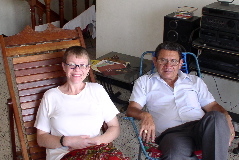
Chris and Gabel Sotíl, during a meeting to coordinate Iquito and Omagua project activities
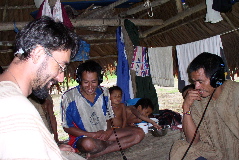
Migzero (right), the chief of Montetoni, listens to arecording of a conversation made by Lev (left).
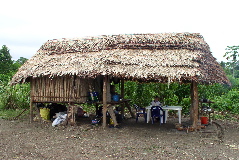
Chris at work in Lev and Chris' hut in the Nanti community of Montetoni
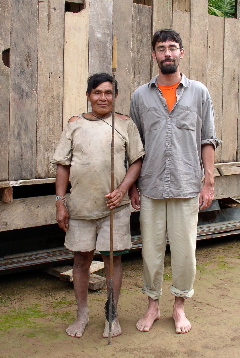
Lev stands with Emilio, a Machiguenga friend, and a Mashco Piro arrow Emilio found in the forest.
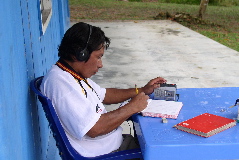
Marcelo Inuma Sinchija, one of the Iquito community linguists, works on transcribing a lengthy traditional narrative
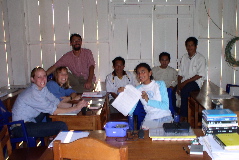
The Iquito Language Documentation linguistic team in 2004 (left to right): Taryne Hallett, Cynthia Anderson, Lev Michael, Marcelo Inuma, Karina Sullón, Edinson Huamancayo, and Hilter Panduro. Chris Beier is behind the camera.
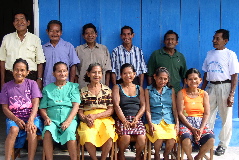
Twelve of the remaining speakers of Iquito at a community celebration in their honor
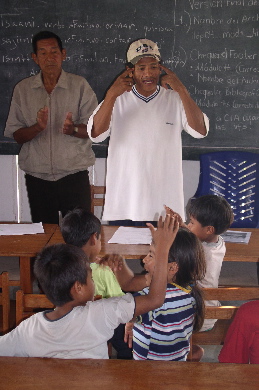
Iquito language speaker Hermenegildo Díaz (left), and community linguist Hilter Panduro (right), teach a children's Iquito language class.